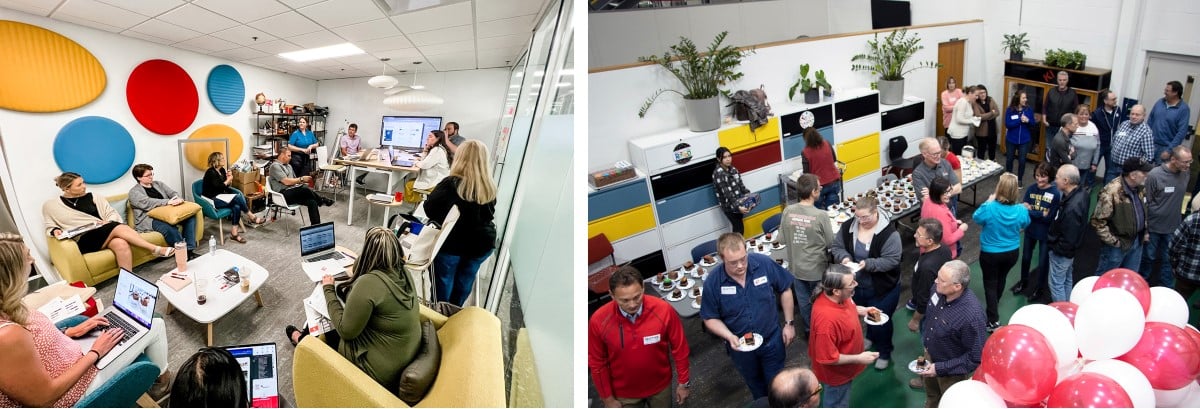- What's New
- Pricing & Purchasing
- Lead Times
- Literature & Samples
- Services & Warranties
- Careers
- Find a Rep
Workplace Well-Being: 7 Core Principles and How to Achieve Them

When it comes to active design, priorities for employees in the modern workplace have shifted over the past decade.
Our latest market research shows that people are looking for their workplaces to support them beyond platonic wellness and broaden the focus to overall well-being.
Simply put, it’s not enough for employers to embrace physical wellness. Employees expect their employers to embrace a holistic approach to offering workspaces that integrate all dimensions of their wellness: emotional, physical, social, professional and financial.
With that in mind, we developed seven core principles to achieving well-being in the workplace. To support each principle, we offer practical design strategies in the insights that follow.
1. Encourage Movement at Work
According to research from Cambridge University, a brisk, 20-minute walk each day can reduce a person’s risk of premature death by up to 30%. That’s quite a return on a minimal investment.
In our survey of professionals in architecture and design and large businesses, respondents agreed that it should be a top standard practice for a workplace to encourage movement and interaction. Employers can meet that demand with workplace design elements, including:
- Flexible spaces that can be used for multiple purposes, from meeting and training rooms to cafés and third spaces.
- Height-adjustable worksurfaces that enable freedom to sit or stand when working throughout the day.
- Intentional floorplans that encourage movement – from “social staircases” for serendipitous interaction among colleagues to gathering spaces around an integrated coffee bar near individual workstations.
2. Encourage Healthy Eating at Work
A three-year study of 20,000 employees published in the British Journal of Health Psychology found that adults who ate more nutritiously over 13 days reported a greater sense of purpose at work, as well as improved well-being.
Workplaces can foster an environment that supports healthy eating by integrating several key tactics:
- Offer nutritious food options on-site.
- Equip communal kitchens properly to allow employees to prepare homemade lunches.
- Team up with local restaurants featuring health-conscious menus to offer discounts on meals.
3. Enable Choice at Work
Recent research published by the American Psychology Association found that an increased sense of control over one’s work improved people’s ability to handle the demands of their job and maintain their mental health.
Allowing employees to choose how they work can give them the control they crave for better peace of mind. A few ways to increase choice in the office and enhance company culture include:
- Accommodating diverse work styles.
- Creating a variety of spaces that allow employees to move around and work in different ways while seamlessly integrating technology and the ability to easily reconfigure.
- Incorporating flexible work policies.
4. Create a Sense of Belonging & Connection at Work
Research published in Harvard Business Review found that a strong sense of belonging in the workplace was associated with a 56% increase in job performance, a 50% drop in turnover risk and a 75% reduction in sick days.
In other words, employees want to feel valued at work. Design and business strategies that can help cultivate that feeling of connection include:
- Designating spaces for team meetings to encourage face-to-face check-ins and collaboration in lieu of instant messaging or Zoom calls.
- Recognizing employees’ anniversaries, birthdays and other milestones.
- Promoting a sense of community with an in-office social hub and team social activities.

5. Connect with the Outdoors at Work
Studies show that increased contact with nature during the workday significantly reduces workplace stress and improves overall wellness. Our survey found that bringing the outdoors in the office is a practice that’s increasingly in-demand.
There are several ways firms can design their space with nature in mind, including:
- Maximizing natural sunlight throughout a workspace.
- Offering outdoor access points, such as rooftops or patios, with vegetation or a community garden.
- Providing resources on how to connect with nature nearby, such as trail maps and information on local outdoor hotspots.
6. Foster Growth at Work
According to the Pew Research Center, 63% of workers who left their job in 2021 did so because there were "no opportunities for advancement."
Employees feel valued when they have opportunities to grow professionally. Some elements that can foster employee growth include:
- Designing flexible training environments and offering sessions on professional and personal topics, like personal finance lessons, leadership workshops or yoga and cooking classes.
- Structuring workplace floorplans in a way that encourages less-experienced employees to interact regularly with more senior members of the team.
7. Combat Stress & Burnout at Work
Recent research from Gallup found that employees experiencing burnout are nearly three times more likely to quit their job and 23% more likely to visit the emergency room.
With thoughtful design and cultural changes, employers can make a big difference in their workers’ mental health. Actionable ideas include:
- Implementing meeting-free days and restrictions on email times.
- Increasing the availability of individual quiet pods or rooms where people can take a break to recharge or make sensitive phone calls.
- Bring nature into the office with plants and other nods to biophilia.
Embrace Holistic Well-Being in the Workplace
From back-to-back conference calls to interactions with colleagues to looming deadlines, the workplace can be stressful at times. Fortunately, employers are in a unique position to show their employees that they value them and want to actively contribute to their well-being.
By leveraging design and cultural strategies, employers can make a real difference in the overall health and well-being of their teams – and by extension, the strength of their business.
For a closer look at our seven principles of well-being in the workplace, download our new white paper.
Subscribe
Stay up to date with the latest trends and more.















